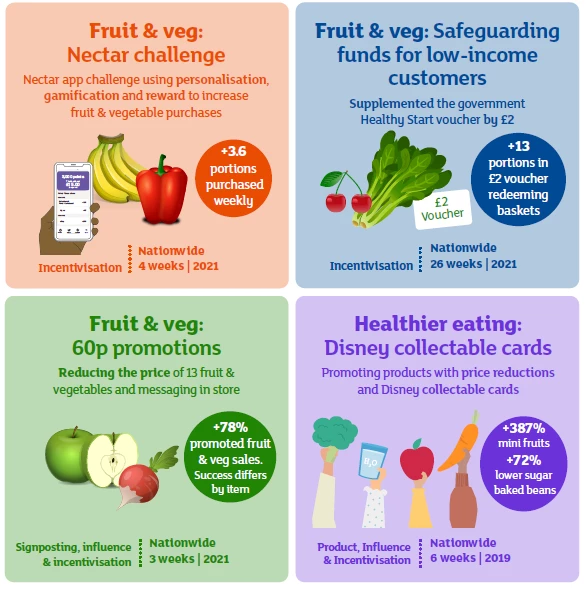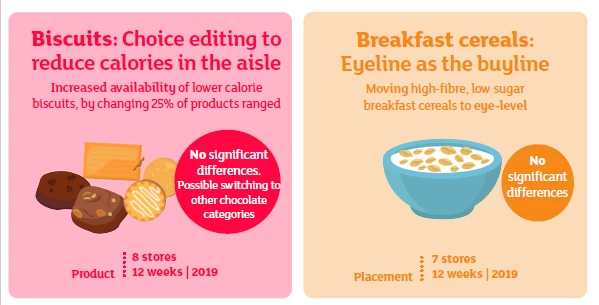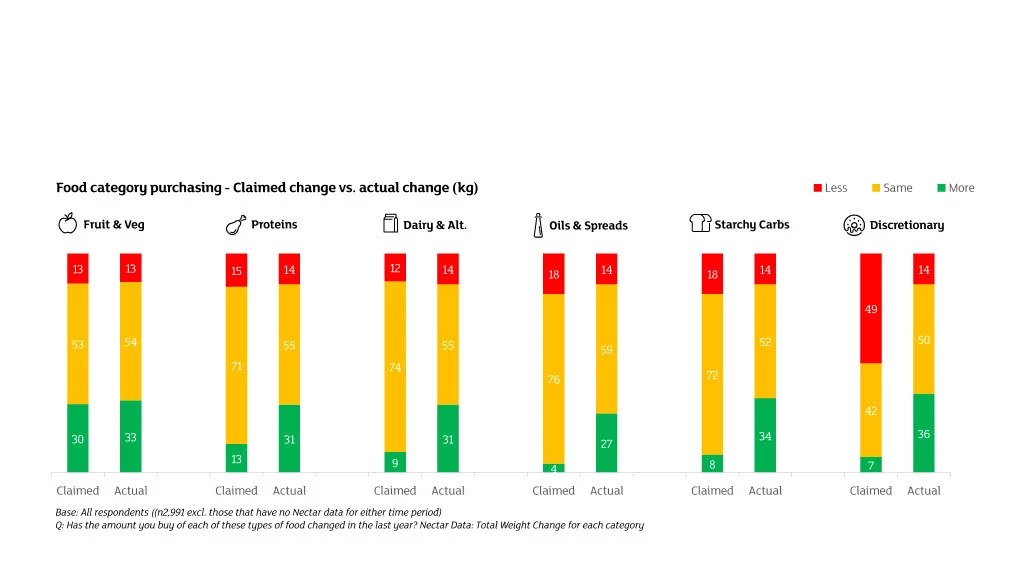What works in real world settings to influence healthier food choices?
In this guest blog, Maddie Thomas and Nilani Sritharan from Sainsbury's look at research in supermarkets on what works when it comes to encouraging customers to make healthier choices.
A full paper with more detail on this work has been published as part of a Nutrition Bulletin Virtual Issue on changing the food retail environment.
The role of retail food environment trials:
Many food businesses are focused on setting, and working towards, a target to drive healthier sales. This can be achieved through pulling on different levers, such as altering the product availability and ranging, investing in price and promotions of healthier items, and campaigns to nudge customers towards better choices.
The retail food environment is one important factor that influences the food we buy1. To date, most retail health trials record at least some positive impacts, and mainly focus on increasing the purchase of healthier foods2. Until recently though, most UK trials had limited real-world application, because they had either been conducted in a virtual environment or for a very short duration - often less than the standard promotional period of 3-4 weeks.
Programmes run by The Consumer Goods Forum (CGF)3 and The Institute of Grocery Distribution (IGD)4 are building the evidence base, by sharing knowledge and best practice of what works in real-world settings. These interventions are independently analysed by academic partners at the University of Oxford and University of Leeds, respectively. Collaborating and using these learnings to co-create interventions means that we can contribute to the evidence needed for more effective health policies. The results of these programmes are summarised below.
What we have learnt from our trials to date:
We’ve been running food environment trials since 2019, compiling insights and independent evaluation from 7 health trials, to learn how best to transition customers’ baskets closer to the UK’s Eatwell Guide. Headline results of our trials are shown below (further details can be found here).
Interventions that worked:

Interventions that didn't work:

Whilst it’s hard to measure the sole impact of the intervention, we can see that incentivisation and reward tactics drive the most meaningful changes. This matches the evidence too, showing that trials that offer some form of incentive, and interventions that pull on multiple different behavioural change levers, deliver the biggest impact.
Evaluating trials in partnership with retailers allows for a more complete picture of the findings. Context that can otherwise be missed, includes:
- Reviewing total sales impacts not just the sales of a particular aisle where the intervention took place.
- Understanding differences in the customer journey by retailing channel: for example, online customers are more likely to start their shop from their ‘favourites’ vs. the customer experience in store.
- Adjusting for weather and seasonal impacts., was it a particularly hot summer, impacting sales of certain products such as BBQ ranges and ice cream.
- Understanding broader supply chain impacts that might also impact product availability, such as adverse weather, a Salmonella outbreak, or conflicts.
- Adjusting for product availability across both test and control stores when exploring the impacts of product placement e.g. at checkouts, on sales.
- Understanding whether an intervention differentially impacted certain customers over others, or indeed, different geographies too.
Our transaction and customer data can also provide insights for identifying the best target customers, and materiality of where to act by sharing what we know about different food categories.
Using customer insights to inform our interventions:
The behaviour intention gap analysis, conducted by Savanta (an independent data and marketing research company) in February 2023, showed that shoppers are much more accurate at estimating the change in their fruit & vegetable purchases than on discretionary items, such as biscuits and confectionery. Whilst literature shows that educational interventions aren’t always successful, these insights could lead to more targeted trials to see if this improves the success.

Looking at the data in more detail, we also saw the increase in discretionary food purchasing over the past year appears to be influenced by factors such as affluence, family status and age. Further analysis of this could enable us to explore targeted interventions to drive more meaningful behaviour change in shopping habits.
What’s next for food retail environment trials?
We know that most British customers shop around, so whilst loyalty card data gives just a snapshot of food people are purchasing, it’s still a good indicator of population dietary patterns5 and can be used for evaluation at scale. For example, the effectiveness of the High Fat, Sugar or Salt (HFSS) placement legislation will be independently evaluated for multiple retailers, one year on, as part of the DIO FOOD project6.
As the industry partner of FIO food7, we will be testing and evaluating population level interventions to support people living with food insecurity and obesity access healthy & sustainable foods. This will be informed by population-level insights, and research into the lived experiences of navigating supermarket foodscapes, which you can read about here.
We are continuously improving our data, so that we can unlock more sophisticated health trials, offering more personalised incentives that better match the needs of different customer groups.
- DHSC. Restricting promotions of products high in fat, sugar or salt by location and by volume price: implementation guidance. 29th September 2023.
- UNICEF. Improving urban retail food environments – A research agenda for Eat Asia and Pacific. 22nd July 2021.
- The Consumer Goods Forum. 2020. Can Supermarkets help turn the tide on obesity?
- IGD. 11th October 2022. Healthy Sustainable Diets: Driving Change.
- Victoria L Jenneson, Francesca Pontin, Darren C Greenwood, Graham P Clarke, Michelle A Morris, A systematic review of supermarket automated electronic sales data for population dietary surveillance, Nutrition Reviews, Volume 80, Issue 6, June 2022, Pages 1711–1722
- Diet and Health Inequalities (DIO Food) | The Rowett Institute | The University of Aberdeen (abdn.ac.uk)
- Food Insecurity in people living with Obesity (FIO Food) | The Rowett Institute | The University of Aberdeen (abdn.ac.uk)

Share this page